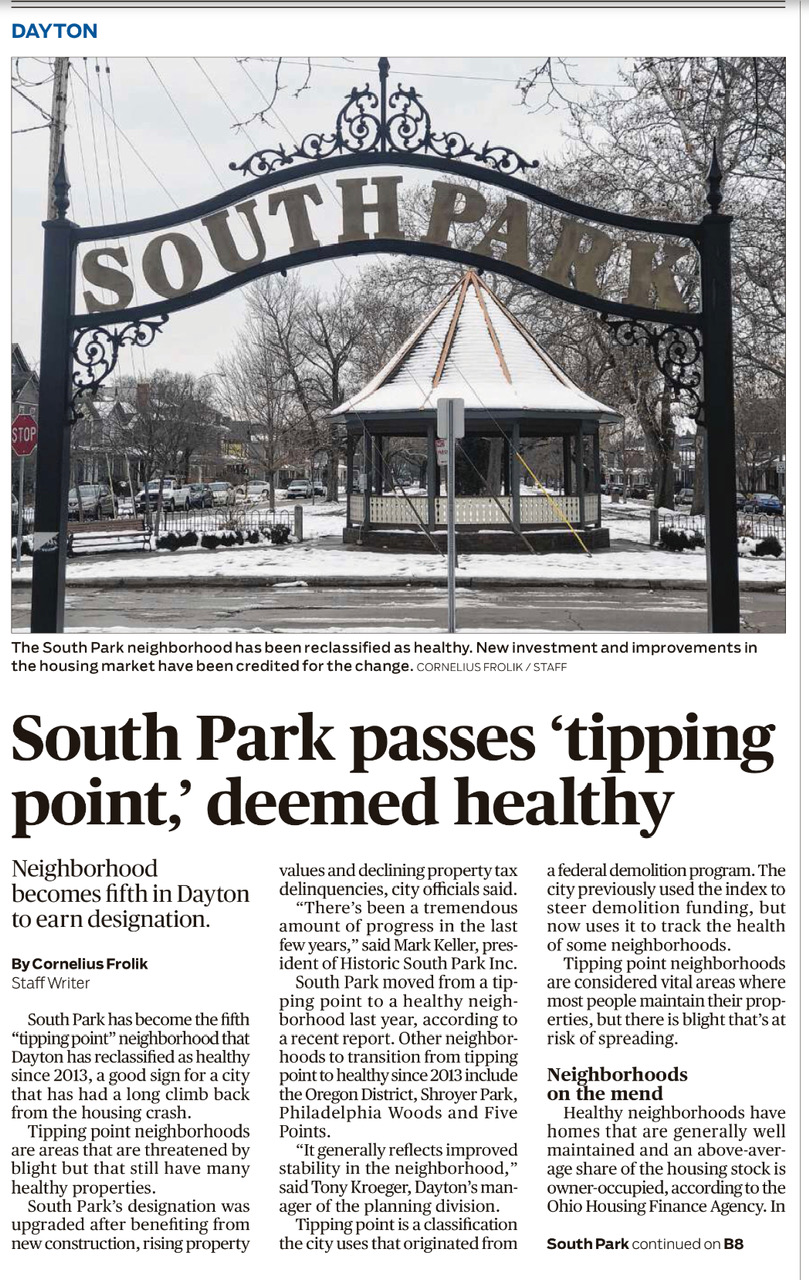Well, the good folks at City Hall have finally determined what we’ve known all along, South Park is a “healthy neighborhood” and it was on the front page of the Dayton Daily News Local section today.
We know that protecting the integrity of real estate is important and that broken windows and leaking roofs lead to a perception of a failing neighborhood, but for us, it was always about the people, our sense of community. That’s what makes South Park a great place to live. It’s the triumph of the human condition, not the valuation of the real estates condition.
Our goals are to create community, and we work really hard to make sure that people feel a sense of pride about living in our borders. That’s why we spend so much time together- be it at Chilli Cookoffs, Hot Toddy Parties, Porch Patio and Deck parties, book clubs or bar takeover nights out.
Here’s the story from the Dayton Daily:
South Park passes ‘tipping point,’ deemed healthy – Dayton Daily News
By Cornelius Frolik Staff Writer
Neighborhood becomes fifth in Dayton to earn designation.
DAYTON
South Park has become the fifth “tipping point” neighborhood that Dayton has reclassified as healthy since 2013, a good sign for a city that has had a long climb back from the housing crash.
Tipping point neighborhoods are areas that are threatened by blight but that still have many healthy properties.
South Park’s designation was upgraded alter benefiting from new construction, rising property values and declining property tax delinquencies, city officials said.
“There’s been a tremendous amount of progress in the last few years,” said Mark Keller, president of Historic South Park Inc.
South Park moved from a tipping point to a healthy neighborhood last year, according to a recent report. Other neighborhoods to transition from tipping point to healthy since 2013 include the Oregon District, Shroyer Park, Philadelphia Woods and Five Points.
“It generally reflects improved stability in the neighborhood,” said Tony Kroeger, Dayton’s manager of the planning division.
Tipping point is a classification the city uses that originated from a federal demolition program. The city previously used the index to steer demolition funding, but now uses it to track the health of some neighborhoods.
Tipping point neighborhoods are considered vital areas where most people maintain their properties, but there is blight that’s at risk of spreading.
Neighborhoods on the mend
Healthy neighborhoods have homes that are generally well maintained and an above-average share of the housing stock is owner-occupied, according to the Ohio Housing Finance Agency. In these areas, blighted properties are more likely to be purchased and cleaned up and market forces generally resolve vacancy and abandonment issues.
The Oregon District was the first to be reclassified, but that was primarily because it was already healthy and was just mislabeled, Kroeger said.
Shroyer Park’s and Five Points’ designations changed because of property value stabilization, Kroeger said. Five Points also was helped by increased interest in the Wright Dunbar Business District.
Philadelphia Woods was reclassified owing to new ownership and renovation of the large apartment buildings on Valerie Arms Drive, Kroeger said.
South Park’s transformation
South Park didn’t transform overnight, but it definitely had a productive 2018.
A new, four-story apartment building opened on the western edge of South Park early in the year.
The 43 Flats at South Park “luxury” apartments filled up fast, and tenants were locked down for the first-floor commercial space. Biggby Coffee signed a lease for about 1,505 square feet of space at the Flats. Cassano’s Pizza King agreed to move into the building.
South Park’s housing market has heated up.
The neighborhood had about 65 valid sales in 2018, up from 51 in 2017, according to Montgomery County Auditor’s Office data.
Some property owners renovated or restored old historic homes to sell. Some houses in the neighborhood sold within days of hitting the market.
‘Very vested neighbors’
Late last year, Wholly Grounds, a new coffee shop, opened at 825 Wayne Ave., in a space formerly occupied by a dog-treat bakery.
Branch & Bone Artisan Ales, a new craft brewery and taproom at 905 Wayne Ave., had its grand opening in June. The business moved into an old auto body shop.
South Park’s success partly is tied to its active and organized group of residents and property owners who coordinate alley sweeps, cleanups, trash pick-ups, plantings and other beautification efforts, said Keller, with Historic South Park Inc.
South Park also regularly hosts events that give neighbors opportunities to interact and get to know one another.
There’s still some problem properties and problem owners, but neighbors keep in close communication and try to stay on top of safety, housing and community concerns, Keller said.
“We have very vested neighbors,” he said.
Other neighborhoods
According to the city, Dayton neighborhoods that have index scores that are in the tipping point range include Belmont, Carillon, College Hill, Dayton View Triangle, Eastern Hills, Fairview, Linden Heights, Madden Hills, Northern Hills, Old North Dayton, University Row and Walnut Hills.
There are at least 20 Dayton neighborhoods that are healthy.
Neighborhoods also can be classified as revitalization neighborhoods or redevelopment areas under the scale the city uses. Some neighborhoods have more than one classification.
Revitalization neighborhoods have seen considerable decline over the years or decades. Between 20 to 70 percent of homes in these areas are blighted. Some revitalization areas included Wolf Creek, Stoney Ridge and McCook Field.
Redevelopment areas have seen the most significant decline. More than 70 percent of properties are blighted and they are “virtual ghost towns,” the state said. Redevelopment areas included Santa Clara, North Riverdale, Southern Dayton View and McFarlane.
Revitalization and redevelopment designations were made in 2013 and aren’t tracked as closely as movement from tipping point to healthy.
The “tipping” of five neighborhoods back to healthy indicates that the city and other partners are successfully stabilizing housing markets and have focused investments and strategies in ways that are generating new confidence in the market, said Alison Goebel, executive director of the Greater Ohio Policy Center.
“Neighborhoods can transform quickly once the ball gets rolling but the right investments are needed to send the ball on its trajectory,” she said.
Contact this reporter at 937-225-0749 or email [email protected].
And, in the name of full disclosure, Mr. Frolik is one of our newest neighbors, after recently purchasing a restored home in the neighborhood.

